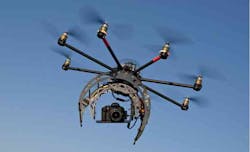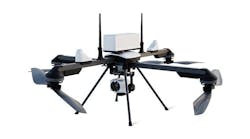June 12--SPRINGFIELD -- An office on Springfield's eastern edge will serve as the base of operations for Ohio and Indiana's joint effort to become a test site for unmanned aerial systems, an industry that's predicted to create thousands of new jobs.
The Ohio/Indiana Unmanned Aerial Systems Center and Test Complex will be housed in leased office space at the Nextedge Applied Research and Technology Park along U.S. 40 in a building owned by Advanced Virtual Engine Test Cell, better known as Avetec.
The Ohio Department of Transportation, which will manage the complex, picked the space from among 15 possible sites, 12 of which were located in Montgomery and Greene counties.
The state controlling board Monday approved ODOT's two-year lease at a total cost of $70,000 that will run from July 1 until June 30, 2015.
It's hoped the creation of the test complex will bolster the two-state effort to win one of six UAS test sites being created nationally later this year by the Federal Aviation Administration. The FAA will use the sites to gather safety and privacy data needed before drones are allowed into manned airspace in 2015.
An industry report in March predicted that unmanned aircraft will create more than 2,700 new Ohio jobs by 2025 and generate $2.1 billion in development. That same report by the Association for Unmanned Vehicle Systems International stated the selection of the test sites will help determine where jobs flow.
Two dozen applicants representing 23 states are in the running for the six test sites, said Joe Zeis, executive vice president and chief strategic officer for the Dayton Development Coalition.
Other states have upped their efforts.
North Dakota recently created the Northern Plains UAS Test Site, which will be led by a former Air National Guard wing commander, with $1 million to pursue an FAA test-site designation. The governor there last month appropriated $4 million more if the FAA picks his state.
"The stakes are pretty high," Rob Nichols, press secretary for Ohio Gov. John Kasich, said Tuesday, preferring not to say what, exactly, the test complex here will do for the Ohio-Indiana application.
The 2,060 square feet of leased space would serve not only as a base of operations for the flight testing of unmanned aircraft in Ohio and Indiana but also as a site for data analysis, modeling, simulations and mission planning, according to a news release from state Sen. Chris Widener, R-Springfield.
The not-for-profit Avetec already has modeling and simulation capabilities. The organization strives to reduce the cost and time it might take the military to develop and test jet engines by doing it virtually.
"It's a coup on one hand, but it more reflects the positive things Springfield is bringing to the table for UAVs in this region," Tom Franzen, assistant city manager and director of economic development, said.
Even if the FAA doesn't pick Ohio and Indiana, drone testing will be done in the region, Nichols said, because of a NASA challenge grant for sense-and-avoid technology.
With the presence of Wright-Patterson Air Force Base, the Dayton-Springfield region has long been viewed as the state's bastion of UAS research and development. The availability of restricted airspace in neighboring Indiana makes for a "wonderfully complementary partnership," Zeis said.
Aside from a smattering of businesses locally already involved in UAS, Springfield's other chief contribution to that partnership is the Springfield-Beckley Municipal Airport, where drones will be launched and recovered on their way to and from restricted airspace. Unmanned aircraft also will be flown from the Wilmington Air Park.
Avetec -- and Nextedge in general -- has been connected via a fiber-optic ring since 2010 to the Springfield airport and to Wright-Patterson, a feature that factored into the site selection.
"That site adds a tremendous amount of value to the state's efforts, not just ours," Franzen said.
The selection also renews hope for the 205-acre local technology park that had stagnated so much during the recession that the bank eventually auctioned it last year for a fraction of the nearly $15 million invested in it. That investment included $6.3 million in public funding for the main infrastructure.
Developed in 2004, when "nobody even knew what a UAV was," Franzen said, Nextedge might finally get to live up to its name by attracting drone developers.
"This will be a nice reminder to folks that we have this amenity in the region," Franzen said.
Copyright 2013 - Dayton Daily News, Ohio


